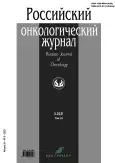Double threat: Ovarian cancer and thrombotic complications
- Authors: Mansurova A.S.1, Krasilnikov S.E.1,2, Voitcitckii V.E.1,3
-
Affiliations:
- Meshalkin National Medical Research Center
- Novosibirsk State Medical University
- Novosibirsk State Medical University Ministry of Health of Russian Federation
- Issue: Vol 26, No 3 (2021)
- Pages: 101-106
- Section: Case Reports
- URL: https://journals.rcsi.science/1028-9984/article/view/107326
- DOI: https://doi.org/10.17816/onco107326
- ID: 107326
Cite item
Abstract
Currently, patients with cancer are undoubtedly more likely to develop thrombosis and thromboembolism. In some cases, symptoms of thrombotic complications could be the first signs of a malignant tumor. Thus, the treatment of such patients should follow two directions: treatment of cancer and maintenance therapy aimed at coagulopathy correction. Anticoagulant and antiplatelet therapies are high priorities in the treatment of these conditions; however, their adverse effects should not be forgotten–high risk of bleeding. There is a very fine line between the risks of thromboembolic complications and bleeding; both conditions can threaten the patient’s life. Thus, a multidisciplinary approach, timing, and balanced treatment can save patients’ lives.
Keywords
Full Text
##article.viewOnOriginalSite##About the authors
Alfiya S. Mansurova
Meshalkin National Medical Research Center
Email: mansurova_a@meshalkin.ru
ORCID iD: 0000-0002-4754-0384
SPIN-code: 5523-6787
MD, Research associate of the Institute of Oncology and Neurosurgery, Meshalkin National Medical Research Center, Ministry of Health of Russian Federation
Russian Federation, 15 Rechkunovskaya Street, 630055 Novosibirsk, Russian FederationSergey E. Krasilnikov
Meshalkin National Medical Research Center; Novosibirsk State Medical University
Email: professorkrasilnikov@rambler.ru
MD, Ph.D., DrSc (Med), Professor, Director of the Institute of Oncology and Neurosurgery, Meshalkin National Medical Research Center, Ministry of Health of Russian Federation; Professor of the Department of Oncology, Novosibirsk State Medical University Ministry of Health of Russian Federation
Russian Federation, 15 Rechkunovskaya Street, 630055 Novosibirsk, Russian Federation; 52 Krasny Prospect, 630091 Novosibirsk, Russian FederationVladimir E. Voitcitckii
Meshalkin National Medical Research Center; Novosibirsk State Medical University Ministry of Health of Russian Federation
Author for correspondence.
Email: v.vladimir2020@mail.ru
MD, Ph.D., DrSc (Med), Professor, Leading Researcher of the Institute of Oncology and Neurosurgery, Meshalkin National Medical Research Center, Ministry of Health of Russian Federation; Head of the Department of Oncology, Novosibirsk State Medical University Ministry of Health of Russian Federation
Russian Federation, 15 Rechkunovskaya Street, 630055 Novosibirsk, Russian Federation; 52 Krasny Prospect, 630091 Novosibirsk, Russian FederationReferences
- Lecumberri R, Marqués M, Panizo E, et al. High incidence of venous thromboembolism despite electronic alerts for thromboprophylaxis in hospitalised cancer patients. ThrombHaemost. 2013;110(1):184–190. doi: 10.1160/TH13-02-0131
- Khorana AA. Risk assessment for cancer-associated thrombosis: what is the best approach? ThrombRes. 2012;129(1):S10-5. doi: 10.1016/S0049-3848(12)70009-9
- Zamorano JL, Lancellotti P, Rodriguez Muñoz D, et al. ESC Scientific DocumentGroup. 2016 ESC Position Paper on cancer treatments and cardiovascular toxicity developed under the auspices of the ESC Committee for Practice Guidelines: The Task Force for cancer treatments and cardiovascular toxicity of the European Society of Cardiology (ESC). EurHeartJ. 2016;37(36):2768–2801. doi: 10.1093/eurheartj/ehw211
- Ter-Ovanesov MD. Tromboticheskie oslozhneniya v onkologii:opyt, realizovannyy na praktike / MD Ter-Ovanesov, AV Madzhuga. Prakticheskaya onkologiya . 2001;2(05):25–32.(In Russ).
- Dammacco F, Vacca A, Procaccio P, et al. Cancer-related coagulopathy (Trousseau’s syndrome): review of the literature and experience of a single center of internal medicine. ClinExpMed. 2013;13(2):85–97. doi: 10.1007/s10238-013-0230-0
- Dvoretsky LI, Dyadkov IN, Stepanchenko AP, Dubrovskaya NV. Venous thromboembolism as the first manifestation of disseminated malignancy (Trussos syndrome). Bulletin of Siberian Medicine. 2019;18(3):232–237. (In Russ). doi: 10.20538/1682-0363-2019-3-232–237
- Vorobev AV, Chabrov AM, Savchenko AA. Pathogenesis of Trousseau’s syndrome. Obstetrics, gynecologyandreproduction. 2015;9(2):99–109. (In Russ). doi: 10.17749/2070-4968.2015.9.2.099-109
- Maximova MY, Smirnova IN, Loskutnikov MA. Paraneoplasticheskaya koagulopatiya kak prichina povtornykh narusheniy mozgovogo krovoobrashcheniya (kliniko-morfologicheskoe nablyudenie). Annals of Clinical and Experimental Neurology. 2013;7(1):39–44. (In Russ). doi: 10.17816/psaic245
Supplementary files








